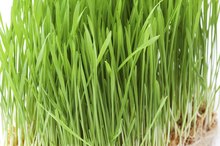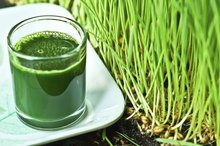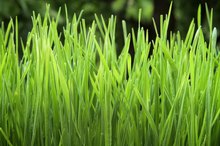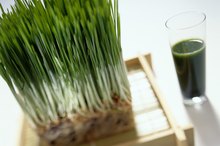Can You Eat Wheatgrass Raw?
The flour used in wheat bread comes from milled wheat berries. In the fall of the year, the farmer plants wheat berries, and in the spring, they grow into tender young shoots. Called wheatgrass, these green leaf-like shoots contain nutrients that are potentially beneficial to your health. Yes, you can eat raw wheatgrass, but juicing is the most common way of extracting and serving this green source of nutrition.
History
Ann Wigmore, 20th century author and natural health advocate, introduced wheatgrass to the public with the publication of “The Wheatgrass Book” in 1985. As news of the nutritional benefits of wheatgrass spread, other books, including, “Wheatgrass: Nature’s Finest Medicine,” by Steve Meyerowitz, appeared on bookstore shelves.
Consumption Methods
Wheatgrass & Weight Loss
Learn More
Wheatgrass juice, extracted from the tender shoots, requires the use of a juicer, but freeze-dried wheatgrass is also available in tablet and capsule forms. For the freshest wheatgrass, Meyerowitz, tells his readers to, “Just grab a handful and munch.”
Growing/Harvesting
Harvest wheatgrass when the leaf-like shoots are 8 in. to 10 in. high, recommends Meyerowitz. The “Gale Encyclopedia of Alternative Medicine,” says to harvest before the wheat berry heads form. While Midwestern farmers plant thousands of acres of wheat, you may find it beneficial to grown your own wheatgrass indoors in trays. Wheatgrass kits are available in health food stores and online.
- Harvest wheatgrass when the leaf-like shoots are 8 in.
- While Midwestern farmers plant thousands of acres of wheat, you may find it beneficial to grown your own wheatgrass indoors in trays.
Nutritional Content
Difference Between Wheat & Wheatgrass
Learn More
Wheatgrass contains many nutrients, according to Verdure.com, including vitamins A, C, E, calcium amino acids, magnesium, iron and chlorophyll. It is also a source of dietary fiber, and it is low in calories.
Potential Benefits
Clinical studies do not confirm the medicinal benefits of wheatgrass in the treatment of diabetes, cancer, infections, digestive disorders and skin disorders. However, eating wheatgrass can count toward your daily serving of vegetables.
Concerns
Those with allergies to wheat should not eat wheatgrass, advises the “Gale Encyclopedia.” The FDA does not oversee the production or sale of wheatgrass, fresh or in supplements, so there is no guarantee of quality or safety. In addition, wheatgrass may develop mold around the lower part of the shoots that may not be healthy for consumption, according to Meyerowitz. Eating wheat grass on an empty stomach may cause nausea in some individuals.
Related Articles
References
- “Wheatgrass: Nature’s Finest Medicine”; Steve Meyerowitz, 2006
- Verdure: Wheatgrass
- “Gale Encyclopedia of Alternative Medicine, Volume 2”; Jacqueline L. Longe; 2005
- Wheat grass powder. FoodData Central. U.S. Department of Agriculture. Published April 1, 2019.
- Renu M, Preeti R. Health benefits of wheat grass — a wonder food. Int J Food Nutr Sci. 2013;2(4):10-13.
- Bar-Sela G, Cohen M, Ben-Arye E, Epelbaum R. The medical use of wheatgrass: Review of the gap between basic and clinical applications. Mini Rev Med Chem. 2015;15(12):1002-10. doi:10.2174/138955751512150731112836
- Wan P, Chen H, Guo Y, Bai AP. Advances in treatment of ulcerative colitis with herbs: From bench to bedside. World J Gastroenterol. 2014;20(39):14099-104. doi:10.3748/wjg.v20.i39.14099
- Bar-Sela G, Tsalic M, Fried G, Goldberg H. Wheat grass juice may improve hematological toxicity related to chemotherapy in breast cancer patients: A pilot study. Nutr Cancer. 2007;58(1):43-8. doi:10.1080/01635580701308083
- Kyada A, Chorai P. Myeloprotective effect of Triticum aestivum Linn. grass against antineoplastic agents induced bone marrow toxicity in mice. Trends in Pharmaceutical Sciences. 2017;3(3):169-180.
- Kothari S, Jain AK, Mehta SC, Tonpay SD. Hypolipidemic effect of fresh Triticum aestivum (wheat) grass juice in hypercholesterolemic rats. Acta Pol Pharm. 2011;68(2):291-4.
- Mutha AS, Shah KU, Kinikar AA, Ghongane BB. Efficacy and safety of wheat grass in thalassemic children on regular blood transfusion. Cureus. 2018;10(3):e2306. doi:10.7759/cureus.2306
- Parit SB, Dawkar VV, Tanpure RS, Pai SR, Chougale AD. Nutritional quality and antioxidant activity of wheatgrass (Triticum aestivum) unwrap by proteome profiling and DPPH and FRAP assays. J Food Sci. 2018;83(8):2127-2139. doi:10.1111/1750-3841.14224
- Wheat grass cold pressed juice. FoodData Central. U.S. Department of Agriculture. Published April 1, 2019.
Writer Bio
Glenda Taylor is a contractor and a full-time writer specializing in construction writing. She also enjoys writing business and finance, food and drink and pet-related articles. Her education includes marketing and a bachelor's degree in journalism from the University of Kansas.









